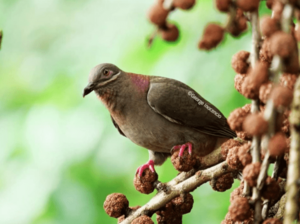Amethyst brown dove facts for kids
Quick facts for kids Amethyst brown dove |
|
|---|---|
 |
|
| Conservation status | |
| Scientific classification | |
| Genus: |
Phapitreron
|
| Species: |
amethystinus
|
The amethyst brown dove (Phapitreron amethystinus) is a beautiful bird that belongs to the Columbidae family, which includes all doves and pigeons.
This special dove lives only in the Philippines. You can find it on islands like Luzon, Polillo Islands, Catanduanes, Samar, Bohol, and Mindanao. It's not very common in most places where it lives. These doves prefer to live in tropical forests, both in lowlands and in mountains, usually between 500 and 2000 meters high.
You'll often see them alone or in pairs, especially near trees that have fruit. They make a deep "hoop" sound or a fast "poo-poo-poo-poop" call. They can sit and call for a long time!
Contents
What Does It Look Like?
The amethyst brown dove is quite striking! It looks a lot like another bird called the white-eared brown dove. Both have white lines just under their eyes.
However, the amethyst brown dove is usually darker brown. Its beak is also longer and heavier than its leg. A cool feature is the bright blue-purple patch on its back, near its neck.
Other features include:
- A greyish color with purplish-brown feathers underneath.
- Rich tan feathers under its tail.
- Dark and white lines below its eyes.
- A reddish-brown chin and throat with darker stripes.
- Its chest is a medium to dark dull brown.
- It has pink skin around its eyes.
- The purple color on its neck (called the nape) looks shiny, like an amethyst gem.
Different Kinds of Amethyst Brown Doves
Scientists recognize four different types, or subspecies, of the amethyst brown dove. These are slightly different versions of the same species, often found in different places.
- P. a. amethystinus: This type lives on Luzon, Samar, Dinagat, Mindanao, Bohol, Polillo Island, and Catanduanes. It's larger and doesn't look as metallic (shiny) as some others.
- P. a. imeldae: You can find this one on Marinduque. It has a more metallic look on its back and is smaller.
- P. a. maculipectus: This subspecies lives on Panay and Negros. It has a distinct grey chest and looks lighter overall.
- P. a. frontalis: This type was found on Cebu. It looks darker overall and doesn't have the white stripe under its eye. Sadly, it might be extinct, meaning it no longer exists. It hasn't been seen since 1892.
Some bird experts have recently decided to split these doves into three separate species. The first two types (amethystinus and imeldae) are still called the Amethyst Brown Dove. The maculipectus type is now called the Grey-breasted Brown-Dove. And the frontalis type, from Cebu, is called the Cebu Brown Dove.
Where They Live and How They Are Doing
These doves live in tropical forests, from lowlands up to 2,500 meters high. They like humid areas and dense secondary forests (forests that have regrown after being cut down).
The number of these doves varies across the Philippines. Organizations like the IUCN Red List check how many birds are left and if they are in danger. They look at each of the newly split species separately.
Amethyst Brown Dove (P. a. amethystinus and imeldae)
We don't know the exact number of these doves in the world. They are generally uncommon, but they are quite common in the Sierra Madre mountains in northern Luzon. Their population seems stable, which means their numbers are not going down quickly. Because of this, they are listed as a Least-concern species. This means they are not currently in danger of extinction.
Grey-breasted Brown Dove (P. a. maculipectus)
This type of dove is very rare. Negros island, where it lives, has lost most of its forests. These doves can only be found in the small pieces of forest that are left. We don't know much about their numbers on Panay island, but there might be more there. Experts think there are only about 2,500 to 9,999 adult birds left, and their numbers are still dropping. The main problems they face are losing their homes (habitat loss) and being hunted for food or to be sold as pets.
Cebu Brown Dove (P. a. frontalis)
This dove hasn't been officially seen since 1892. However, there have been some possible sightings between 2007 and 2012, but these haven't been fully confirmed. If any are still alive, they are in great danger from losing their homes and from poaching (illegal hunting). Cebu island has lost almost all of its original forest, making it the most deforested large island in the Philippines.
Because it's so rare, the Cebu brown dove is listed as Critically Endangered. This means it's very close to extinction, and it's even listed as "Possibly extinct." If any are left, there are probably fewer than 50 adult birds. It's also on a special list called the EDGE species list, which highlights unique and endangered species.


